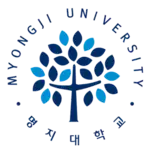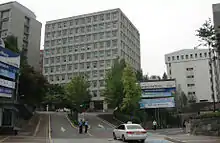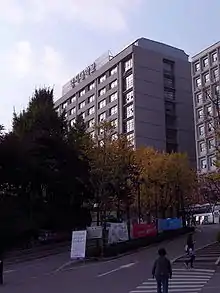Myongji University
Myongji University (Korean: 명지대학교; Hanja: 明知大學校) is a private, Christian university founded in 1948 in South Korea. It provides higher education in the fields of engineering, sciences and humanities. It has two campuses: the Social Science Campus is located in Seoul and the Natural Science Campus is in Yongin which is 35 kilometres (22 mi) south of the capital. It is made up of 10 colleges, 42 departments, seven faculties and eight specialized postgraduate programs.[4]
 | |
| Type | Private, Christian university |
|---|---|
| Established | 1948 |
| President | You Byong-Jin Ph.D.[1] |
| Undergraduates | 22,023[2] |
| Postgraduates | 2,625[3] |
| Location | , 37°34′51″N 126°55′26″E |
| Campus | Urban |
| Colors | Blue |
| Nickname | MJU |
| Mascot | White Stallion |
| Website | Myongji University |
 | |
| Korean name | |
| Hangul | |
| Hanja | |
| Revised Romanization | Myeongjidaehakgyo |
| McCune–Reischauer | Myŏngchitaehakkyo |
Myongji University has been a center for practical humanism over the past half century, and is operating various and practical globalization programs while having exchange with 150 universities in 22 different countries.[5]
History
Myongji University set off as Seoul Primary College of Home Economics, established by Moo-gung Institution in 1948 and in 1953, established Geunhwa Women's Primary College. In 1955, its name was changed to Seoul's Primary Women's College. In 1956, it was reorganized as a coeducation school, Seoul College of Education of Liberal Arts and Science. Then, Christian founding spirit and education policy was set up. According to timely demand of reinforcement of vocational training, its name was changed again to Seoul Practical College of Liberal Arts and Science in 1962.[6]

The school's name was changed from Moo-gung Institution to Myongji Institution based on Christian faith. After the inauguration of President Sang-geun You in 1964, its name changed to Myongji University. After being approved as a 4-year University, school planned and designed the 10 Developmental Programs including building new lecture halls, making and reorganizing departments, establishing graduate schools, etc.[7]
Memorial Arch status raised to university on September 8, 1983 and made departments of politics and home economics, modified department quota. By active support of Myongji Institute, Yongin Campus was built and made growth such as founding of affiliated facility, Extension University dividing natural and social science campus in two different campuses.[8]
On September 13, 1994, the Arts and Design Center was built in industry-academia cooperation of Myongji University and Nasan Group. Myongji University had a New Millennium Proclamation Ceremony to make creative epistemic community that will lead 21st century's Korea and to cope with rapidly changing university environment. It is also taking off to be a university living Christian faith, creativity, innovation, action and a university that becomes power of future society.[9]
Symbol and mascot
The leafed tree symbolizes the founding spirit of the Myong Ji Educational Foundation to imbue the students with the Christian faith, so that they may become devoted and capable leaders who can contribute to the advancement of our culture and national prosperity and ultimately to the realization of world peace.
The white stallion is a symbol of loyalty, courage, obedience, and purity. It is also a reference to the equestrian origins of the Korean people. The school mascot is, therefore, a representation of the profound hope that Myongjians, like the white stallion, will be steeped in such virtues as loyalty, courage, obedience, and purity, as they gallop into the world for the realization of God's kingdom here on earth.
Organization
Undergraduate





- College of Humanities
- Korean Language and Literature
- History
- Library & Information Science
- Japanese Language and Literature
- Creative Writing
- Arabic Studies
- Art History
- Chinese Language and Literature
- English Language and Literature
- Philosophy
- College of Social Science
- Public Administration
- Digital Media
- North Korean Studies
- Political Science and Diplomacy
- Youth Education and Leadership
- Child Development and Education
- Economics
- Department of Social Welfare
- College of Business Administration
- Business Administration
- International Business and Trade
- Real Estate
- Management Information
- College of Engineering
- Electrical Engineering
- Civil and Environmental Engineering
- Chemical Engineering
- Industrial and Management Engineering
- Computer Engineering
- Communication Engineering
- Mechanical Engineering
- Environmental Engineering and Biotechnology
- Electronics Engineering
- Transportation Engineering
- Materials Science & Engineering
- College of Natural Science
- Mathematics
- Division of Biosciences and Bioinformatics
- Food and Nutrition
- Chemistry
- Physics
- College of Arts and Physical Education
- Division of Design
- Division of Film and Musical (formerly, Division of Culture and Arts)[10]
- Baduk Studies
- Division of Music
- Division of Physical Education, Sport and Leisure Studies
- College of Architecture
- Division of Architecture
- Space Design
- Bangmok College of General Education
- Division of general education in social science campus
- Division of Open Major in Social Sciences
- Division of general education in natural science campus
- Division of Open Major in Natural Sciences
- Department of Teacher Training
Baduk studies
The Department of Baduk studies was established in 1997, for the first time in world history, to pursue an academic study of baduk. The Department of Baduk Studies has been set up with the following aims:
- To promote students' game strength above the 5 dan level
- To acquire a deeper knowledge of life from Baduk culture
- To develop and educate the leaders in the field of baduk
- To teach necessary foreign languages to those who can introduce baduk culture to the world
The department teaches baduk theory and technique systematically, researches baduk culture in depth, and acquires wide knowledge related to the game. The graduates will make proper baduk leaders in Korea and foreign countries.
The area of the Baduk Studies is divided into the nature of baduk, technical theory, practical matches, related fields, baduk education, and professional administration, to name a few.
In 1997, Baduk Instruction Studies was established in the College of Arts and Physical Education as a course. In 1998 it was promoted as an independent Department in the College of Arts and Physical Science, The enrollment quota was increased to 30, in 1999. In 2000 the first Bachelor of Arts in Baduk Studies appeared and in 2001 the Graduate School of Baduk Studies was opened. By 2003 the first Master of Arts in Baduk Studies appeared.
Graduate school
- College of Law
- Graduate School of Education
- Graduate School of Archival Sciences
- Graduate School of Social Education
- Graduate School of Social Welfare
- Graduate School of Industrial Technology
- Graduate School of Distribution & Logistics
- Graduate School of Business and Economics in Information
- Graduate School of Investment Information
International Graduate School
The programs are offered in English (however, the website is only available in Korean):
- Engineering design and management (specialization in electronics and communications engineering, mechanical and automobile engineering, environmental engineering, computer engineering and software)
- Intercultural studies
Academic profile
Admission
Applications are invited for undergraduate and graduate programs twice a year. For fall semester starting in the end of August applications are open from October 1 to November 30. For spring semester starting in the end of February applications are open from April 1 to May 31.
Scholarships
For graduate studies, Myongji University Professors offer scholarship from research funds, TAship, RAship or support through Korean government scholarships like IITA-English IITA-Main or KRF. Other scholarships are also provided by university at graduate and undergraduate levels.
Research laboratories
Myongji University maintains a large number of research laboratories for areas such as computing, engineering, and biosciences.
Notable alumni
Linguistics
- Seong Baek-in (1968–1982), scholar of the Manchu language[11]
Sports
- Park Ji-sung, footballer, captain of South Korean National team, mid-fielder for Manchester United
- Ahn Seon-tae, footballer, defender for Daejeon KHNP
- Cho Hyung-ik, footballer for Daegu FC
- Chu Jung-hyun, footballer for Mokpo City FC
- Han Tae-you, footballer for FC Seoul
- Jeon Kwang-jin, footballer
- Kim Bong-rae, footballer for Jeju United
- Kim Jung-hyuk, retired footballer and manager of Mokpo City FC
- Kim Kyung-rae, retired footballer, winner of K League Best XI in 1994 K League
- Kim Min-kyun, footballer for FC Anyang
- Koo Bon-sang, footballer for Ulsan Hyundai
- Moon Byung-woo footballer for Daejeon Korail FC
- Na Kwang-hyun, footballer
- Park Jae-hong, footballer
Music
- Lee Taemin (SHINee)
- Key (SHINee)[13]
- Kim Jong-hyun (SHINee)[14]
- Kim Junsu (TVXQ and JYJ)[15]
- Kim Kwang-seok
- Byun Baek-hyun (EXO)
- Jeon Boram (T-ara)
- Kim Ye-won (Jewelry)
- Kim Yu-bin (Wonder Girls)
- Lee Donghae (Super Junior)
- Lee Moon-se
- Lee Sung-min (Super Junior)
- Qri (T-ara)
- Sim Soo-bong
- Teddy Park
- Yoon Bo-ra (Sistar)
- Yunho (TVXQ)
- Sandeul (B1A4)
- Yoon Ji-sung (Wanna One)
- Lina (The Grace and Isak N Jiyeon)
- Nayun (Momoland)
- Seo You Kyung (AOA Black, Sponge★Band and P.AZIT)
- Donghyun/Kim Dong-hyun (Boyfriend)
- Eunji (Brave Girls)
- Yooseung (M.Pire)
- Yeoeun (Melody Day)
- Yujeong (LABOUM)
Theater, film and television
References
- "Message from the University President". Myongji University.
- "Undergraduate School Statistics". Myongji University.
- "Myongji University Graduate Statistics". Myongji University.
- "Myongji University". Top Universities.
- "Globalization key mission for Myongji University". Korea Times.
- "Quickening Stage". Myongji University.
- "Growing Stage". Myongji University.
- "Developing Stage". Myongji University.
- "Leaping Stage". Myongji University.
- "Division of Film and Musical". Myongji University.
- 교수진, Department of Linguistics, Seoul National University, archived from the original on June 15, 2011, retrieved May 27, 2010
- "명지대 총장에 宋梓씨 선임" [Song Ja named to Myongji U. chancellorship]. Yonhap News. 1997-06-13. Retrieved 2013-10-17.
- "'高졸업' 샤이니 키 "성인 된만큼 더욱 책임감 갖겠다"". February 10, 2010. Retrieved September 1, 2016.
- Kwon, Joon-hyup (December 18, 2017). ""우울증 힘들다" '샤이니' 종현 사망". Kukmin Ilbo (in Korean). Retrieved February 19, 2018.
- "씨앤앰, '명지 뮤지컬 콘테스트' 공동 주최". ZD Net Korea.
명지대학교 뮤지컬공연학과는 지난 2005년도에 신설됐으며, 현재 동방신기의 유노윤호·시아준수, 슈퍼주니어의 동해·성민, 원더걸스 유빈 등이 재학 중이다.
- "Park Bo-gum On College, Acting, and His Seniors". TV Daily.
- "박보검 "졸업식 떨리고 긴장…4년 동안 많이 배워"". XSports News.
- "Myongji ambassadors gathered in one place". Yonhap.